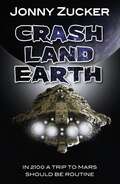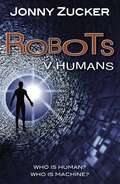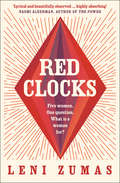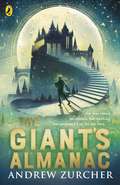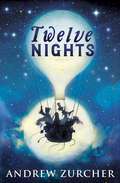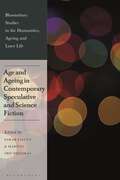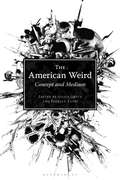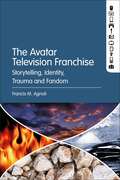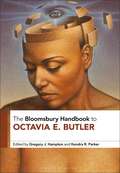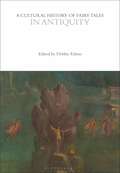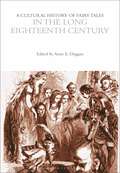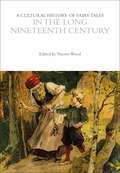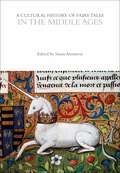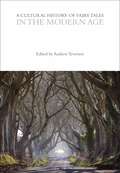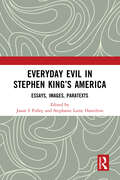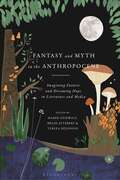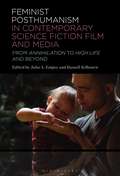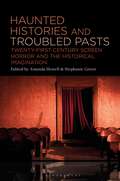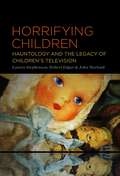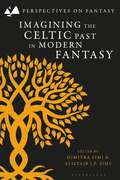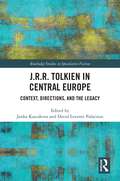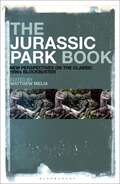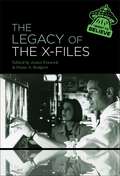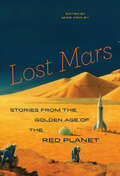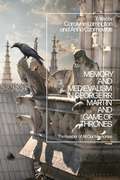- Table View
- List View
Crash Land Earth (Toxic Ser.)
by Jonny ZuckerThe world's first school trip to Mars goes terribly wrong. Now the kids are trapped on a strange planet. It certainly looks like Earth, but why is everyone they meet acting so strangely? Jed and his fellow explorers find themselves in a race against time to save planet Earth. Action! Adventure! Danger! This standalone book from Jonny Zucker's Toxic series is a fast-moving chapter book, filled with high-quality black and white illustrations to grab readers' attention. The Toxic series reads are ideal for reluctant and struggling readers who are enthused by short, fast-paced adventure stories. The cliff-hanger at the end of nearly every chapter certainly helps!
Robots v Humans (Toxic Ser.)
by Jonny ZuckerWho is a robot and who is human? Only one person knows.
Red Clocks: A Novel
by Leni ZumasSHORTLISTED FOR THE INAUGURAL ORWELL PRIZE FOR POLITICAL FICTION ‘Intense, beautifully crafted . . . Her talent is electric. Get ready for a shock’ Guardian This is a work of fiction. Keep telling yourself that.
The Giant's Almanac
by Andrew ZurcherFitz thinks he is an ordinary eleven-year-old and loves to turn simple things into mini-adventures, like sneaking next door and filching books from Mr Ahmadi's vast library of mysterious tomes, and goading the guard dog into giving breakneck chase. But one tranquil evening three sharp knocks on the front door change everything . . . 'I said I would come for him. He is my jewel. It is time. It is past time.'Now on the run from a threat that has been waiting his entire life, Fitz's only hope is to put his life in the hands of his enigmatic neighbour, Mr Ahmadi. Taken on as an apprentice in a secret society who keep all they really do cloaked in mystery, Fitz has to quickly learn the ropes within the most skilful, most powerful, most dangerous and wealthiest organisation in the world . . .
Twelve Nights
by Andrew ZurcherTwelve Nights is the perfect fantasy novel for fans of the magical worlds of Philip Pullman and Terry Pratchett. **********Kay felt everything change in the room around her. Everything. Kay's father is working late- as usual. Fed up, her mother bundles Kay and her sister into the car, and drives to his Cambridge college to collect him. But, the staff say nobody by his name has ever worked there. When they return home, Kay discovers a card left on her pillow: Will O. de Wisp, Gent. F.H.S.P. and Phillip R. T. Gibbet, Gent. F.H.S.P. K.Bith. REMOVALS.That night, Kay is woken by voices at her window: the voices of Will and Phillip, the Removers. But they are not human. And Kay shouldn't be able to see them. Except she can... **********Andrew Zurcher has created a world as captivating as Lyra's Oxford and Alice's Wonderland. Join Kay and the Removers on their incredible journey.
Age and Ageing in Contemporary Speculative and Science Fiction (Bloomsbury Studies in the Humanities, Ageing and Later Life)
Focusing on the contemporary period, this book brings together critical age studies and contemporary science fiction to establish the centrality of age and ageing in dystopian, speculative and science-fiction imaginaries. Analysing texts from Europe, North America and South Asia, as well as television programmes and films, the contributions range from essays which establish genre-based trends in the representation of age and ageing, to very focused studies of particular texts and concerns. As a whole, the volume probes the relationship between speculative/science fiction and our understanding of what it is to be a human in time: the time of our own lives and the times of both the past and the future.
The American Weird: Concept and Medium
Hitherto classified as a form of genre fiction, or as a particular aesthetic quality of literature by H. P. Lovecraft, the weird has now come to refer to a broad spectrum of artistic practices and expressions including fiction, film, television, photography, music, and visual and performance art. Largely under-theorized so far, The American Weird brings together perspectives from literary, cultural, media and film studies, and from philosophy, to provide a thorough exploration of the weird mode. Separated into two sections – the first exploring the concept of the weird and the second how it is applied through various media – this book generates new approaches to fundamental questions: Can the weird be conceptualized as a generic category, as an aesthetic mode or as an epistemological position? May the weird be thought through in similar ways to what Sianne Ngai calls the zany, the cute, and the interesting? What are the transformations it has undergone aesthetically and politically since its inception in the early twentieth century? Which strands of contemporary critical theory and philosophy have engaged in a dialogue with the discourses of and on the weird? And what is specifically “American” about this aesthetic mode?As the first comprehensive, interdisciplinary study of the weird, this book not only explores the writings of Lovecraft, Caitlín Kiernan, China Miéville, and Jeff VanderMeer, but also the graphic novels of Alan Moore, the music of Captain Beefheart, the television show Twin Peaks and the films of Lily Amirpour, Matthew Barney, David Lynch, and Jordan Peele.
The Avatar Television Franchise: Storytelling, Identity, Trauma, and Fandom
Nickelodeon's Avatar: The Last Airbender (2005-08) and its sequel The Legend of Korra (2012-14) are among the most acclaimed and influential U.S. animated television series of the 21st century. Yet, despite their elevated status, there have been few academic works published about them. The Avatar Television Franchise: Storytelling, Identity, Trauma, Fandom and Reception remedies this gap by bringing together a wide range of scholarly writings on these shows. This edited collection is comprised of 13 chapters organized into 4 sections, featuring close readings of key episodes, analyzing how they create meaning as well as illustrating how established theories can guide those readings. Some chapters explore different theories relating to identity as well as considering the repercussions of depicting real-world identities in these shows, while others examine the various manifestations of trauma from throughout the franchise as well as illustrates different scholarly approaches to the topic. Still others utilize fan studies to understand the myriad ways viewers have responded to and interpreted the Avatar franchise.
The Bloomsbury Handbook to Octavia E. Butler
Octavia E. Butler is widely recognized today as one of the most important figures in contemporary science fiction. Bringing together leading and emerging scholars and covering Butler's complete works from the bestselling novel Kindred, to her short stories and major novel sequences Patternmaster, Xenogenesis and The Parables, this is the most comprehensive Companion to Butler scholarship available today.The Bloomsbury Handbook to Octavia E. Butler covers the full range of contemporary scholarly themes and approaches to the author's work, including:· Cyborgs and the posthuman· Race and African American history· Afrofuturism· Gender and sexuality· New perspectives from Religious Studies, the Environmental Humanities and Disability Studies· New discoveries from the Butler archives at the Huntington LibraryThe book includes a comprehensive bibliography of works by Butler and secondary scholarship on her work as well as an afterword by the novelist Tananarive Due.
A Cultural History of Fairy Tales in Antiquity (The Cultural Histories Series)
How have fairy tales from around the world changed over the centuries? What do they tell us about different cultures and societies? Spanning chronologically from the third millennium BCE through to the seventh century CE and beyond, and geographically from the Mediterranean to the Near East and Asia, this book explores the earliest known evidence of familiar folk tales and fairy tales in the ancient world.Drawing on sources including the Rig Veda, the Epic of Gilgamesh, the Old Testament, the Westcar Papyrus, and the Odyssey, this volume ranges from epic poetry to drama, to fables and proverbs, and from ancient histories to novels.Scholars in Classics, Anthropology, Folklore, and Asian Studies examine the dissemination, adaptation, and cross-cultural interactions of early forms of folk tales, providing new insights into how they functioned and circulated across different societies.An essential resource for scholars and students of ancient literature, history, and cultural studies, this book explores topics including: forms of the marvelous, gender and sexuality, monsters and the monstrous, the significance of spaces, socialization and moral messaging, and the uses and abuses of power.
A Cultural History of Fairy Tales in the Long Eighteenth Century (The Cultural Histories Series)
How have fairy tales from around the world changed over the centuries? What do they tell us about different cultures and societies?This volume traces the evolution of the genre over the period known as the long eighteenth century. It explores key developments including: the French fairy tale vogue of the 1690s, dominated by women authors including Marie-Catherine d'Aulnoy and Marie-Jeanne Lhéritier, the fashion of the oriental tale in the early eighteenth century, launched by Antoine Galland's seminal translation of The Thousand and One Nights from Arabic into French, and the birth of European children's literature in the second half of the eighteenth century. Drawing together contributions from an international range of scholars in history, literature and cultural studies, this volume examines the intersections between diverse national tale traditions through different critical perspectives, producing an authoritative transnational history of the genre. An essential resource for researchers, scholars and students of literature, history and cultural studies, this book explores such themes and topics as: forms of the marvelous, adaptation, gender and sexuality, humans and non-humans, monsters and the monstrous, spaces, socialization, and power.A Cultural History of Fairy Tales (6-volume set)A Cultural History of Fairy Tales in Antiquity is also available as a part of a 6-volume set, A Cultural History of Fairy Tales, tracing fairy tales from antiquity to the present day, available in print, or within a fully-searchable digital library accessible through institutions by annual subscription or on perpetual access (see www.bloomsburyculturalhistory.com). Individual volumes for academics and researchers interested in specific historical periods are also available digitally via www.bloomsburycollections.com.
A Cultural History of Fairy Tales in the Long Nineteenth Century (The Cultural Histories Series)
How have fairy tales from around the world changed over the centuries? What do they tell us about different cultures and societies?This volume explores the period when the European fairy tales conquered the world and shaped the global imagination in its own image. Examining how collectors, children's writers, poets, and artists seized the form to challenge convention and normative ideas, this book explores the fantastic imagination that belies the nineteenth century's materialist and pedestrian reputation. Looking at writers including E.T.A Hoffman, the Brothers Grim, S.T. Coleridge, Walter Scott, Oscar Wilde, Christina Rosetti, George MacDonald, and E. Nesbit, the volume shows how fairy tales touched every aspect of nineteenth century life and thought. It provides new insights into themes including: forms of the marvelous, adaptation, gender and sexuality, humans and non-humans, monsters and the monstrous, spaces, socialization, and power. With contributions from international scholars across disciplines, this volume is an essential resource for researchers, scholars and students of literature, history, and cultural studies.A Cultural History of Fairy Tales (6-volume set)A Cultural History of Fairy Tales in Antiquity is also available as a part of a 6-volume set, A Cultural History of Fairy Tales, tracing fairy tales from antiquity to the present day, available in print, or within a fully-searchable digital library accessible through institutions by annual subscription or on perpetual access (see www.bloomsburyculturalhistory.com). Individual volumes for academics and researchers interested in specific historical periods are also available digitally via www.bloomsburycollections.com.
A Cultural History of Fairy Tales in the Middle Ages (The Cultural Histories Series)
How have fairy tales from around the world changed over the centuries? What do they tell us about different cultures and societies? Spanning the years from 900 to 1500 and traversing geographical borders, from England to France and India to China, this book uniquely examines the tales told, translated, adapted and circulated during the period known as the Middle Ages. Scholars in history, literature and cultural studies explore the development of epic tales of heroes and monsters and enchanted romance narratives. Examining how tales evolved and functioned across different societies during the Middle Ages, this book demonstrates how the plots, themes and motifs used in medieval tales influenced later developments in the genre. An essential resource for researchers, scholars and students of literature, history and cultural studies, this volume explores themes including: forms of the marvelous, adaptation, gender and sexuality, humans and non-humans, monsters and the monstrous, spaces, socialization, and power.A Cultural History of Fairy Tales (6-volume set)A Cultural History of Fairy Tales in Antiquity is also available as a part of a 6-volume set, A Cultural History of Fairy Tales, tracing fairy tales from antiquity to the present day, available in print, or within a fully-searchable digital library accessible through institutions by annual subscription or on perpetual access (see www.bloomsburyculturalhistory.com). Individual volumes for academics and researchers interested in specific historical periods are also available digitally via www.bloomsburycollections.com.
A Cultural History of Fairy Tales in the Modern Age (The Cultural Histories Series)
How have fairy tales from around the world changed over the centuries? What do they tell us about different cultures and societies?Drawing together contributions from an international range of scholars in history, literature, and cultural studies, this volume uniquely examines creative applications of fairy tales in the twentieth and twenty-first centuries. It explores how the fairy tale has become a genre that flourishes on film, on TV, and in digital media, as well as in the older technologies of print, performance, and the visual arts. An essential resource for researchers, scholars and students of literature, history, the visual arts and cultural studies, this book explores such themes and topics as: forms of the marvelous, adaptation, gender and sexuality, humans and non-humans, monsters and the monstrous, spaces, socialization, and power.A Cultural History of Fairy Tales (6-volume set)A Cultural History of Fairy Tales in Antiquity is also available as a part of a 6-volume set, A Cultural History of Fairy Tales, tracing fairy tales from antiquity to the present day, available in print, or within a fully-searchable digital library accessible through institutions by annual subscription or on perpetual access (see www.bloomsburyculturalhistory.com). Individual volumes for academics and researchers interested in specific historical periods are also available digitally via www.bloomsburycollections.com.
Everyday Evil in Stephen King's America: Essays, Images, Paratexts
This edited collection variously interrogates how everyday evil manifests in Stephen King’s now-familiar American imaginary; an imaginary that increases the representational limits of both anticipated and experienced realism. Divided into three parts: I. The Man, II. The Monster, and III. The Re-mediator, the book offers rigorous readings of evil, realism, and popular culture as represented in a range of texts (and paratexts) from the King canon. Rich with images, a photo-essay, and appendices collecting classical texts and cultural detritus germane to King, this book moves away from viewing King’s work primarily through the lens of the “American gothic” and toward the realism that the suspense novelist’s voice (fictional and non-) and influence (literary and popular) indelibly continue to amplify, all the while complicating the traditional divide between serious literature and popular fiction.Stephen King remains perpetually popular. And he is finally receiving the academic treatment he has craved since the early 1980s. Yet still unexamined in the King critical canon is the suspense novelist’s fascination with “everyday evil.” Beyond rigorous interrogations of King’s fictional depictions of “everyday evil” by an array of scholars of different ranks living around the world (Canada, Finland, Hong Kong, the UK), the book, replete with 20 images, considers how King widens the parameters of literary production and appreciation. An integral part of the Americana that King’s five-decades-in-the-making canon configures, of course, includes King himself. King has long made use of self-referentiality in his fiction and nonfiction. Some of his nonfiction, several of our essays reveal, recirculates in paratextual form as “Prefatory Remarks” to new novels or new editions of older ones. The paratexts considered here (both across the volume and in the appendices) offer alternate ways by which to appreciate King and his sphere of influence (literary and popular). Said appendices are a grouping of King's paratexts on his writing as Bachman, appearing here, for the first time, as a cohesive collection. King's influence took off in the 1970s, as is further explored in the book-enveloping three-part photo-essay “King’s America, America’s King: Stephen King & Popular Culture since the 1970s.” About the transformative quality of “everyday evil,” the photo-essay tracks the cultural impacts of King first as an emerging author, then a pop culture phenomenon, and, finally, as an established American literary voice.Everyday Evil in Stephen King's America is designed to appeal to teachers and students of American literature, to Stephen King enthusiasts, as well as to acolytes of Americana since the Vietnam War.
Fantasy and Myth in the Anthropocene: Imagining Futures and Dreaming Hope in Literature and Media
The first study to look at the intersection of the discourse of the Anthropocene within the two highly influential and perennially popular storytelling modes of fantasy and myth, this book articulates the idea that if humanity is to have a future, it needs stories that articulate visions of a biocentric, ecological civilization. As the two story systems that have been humanity's most advanced technologies for collective dreaming, fantastic fiction and myths are helping us adopt a biocentric lens, re-kin us with other forms of life, and assist us in the transition to an ecological civilization. Deliberately moving away from dystopian narratives toward anticipatory imaginations of sustainable futures, this volume blends chapters by top scholars in the fields of climate fiction, science fiction, fantasy, myth, and Young-Adult literature studies with personal reflections by award-winning authors and illustrators of speculative fiction for young audiences such as Jeff Vandermeer, Shaun Tan, Jane Yolen, Katherine Applegate and Joseph Bruchac.Covering the works of major fantasy authors such as J. R. R. Tolkien, Terry Prachett, J. K. Rowling, China Mieville, Barbara Henderson, Jeanette Winterson, John Crowly, Richard Powers, George R. R. Martin and Kim Stanley Robinson, and offering interrogations of cultural expressions set in or from the UK, USA, Nigeria, Ghana, Pacific Islands, New Zealand and Australia, this book frames fantasy and myth as spaces where visions of sustainable futures can be designed with most detail and nuance. Rather than merely criticizing the ecocidal status quo, the book asks how Fantastic stories can mobilize resistance around ideas necessary for the emergence of an ecological civilization.
Feminist Posthumanism in Contemporary Science Fiction Film and Media: From Annihilation to High Life and Beyond
Feminist Posthumanism in Contemporary Science Fiction Film and Media: From Annihilation to High Life and Beyond places posthumanism and feminist theory into dialogue with contemporary science fiction film and media. This essay collection is intimately invested in the debates around the posthuman and the critical posthumanities within a feminist critical-theoretical framework.In this posthumanist light, science fiction as a genre allows for new imaginings of human-technological relations, while it can also be the site of a critique of human exceptionalism and essentialism. In this way, science fiction affords unique opportunities for the scholarly investigation of the relevance and relative applicability of specific posthumanist themes and questions in a particularly rich and wide-ranging popular cultural field of production. One of the reasons for this suitability is the genre's historically longstanding relationship with the critical investigation of gender, specifically the position and relative empowerment of women. The original analyses presented here pay close attention to audiovisual style (including game mechanics), facilitating the critical interrogation of the issues and questions around posthumanism. Where typically the mention of SF in the posthumanist context calls to mind a whole set of (often clichéd) tropes-the cyborg, technologically augmented bodies, AI subjectivities, etc.-this volume's thirteen chapters analyze specific examples of contemporary SF cinema that engage in meaningful ways with the burgeoning field of critical posthumanism, and that utilize such films to interrogate posthumanist and feminist as well as humanistic ideas.
Haunted Histories and Troubled Pasts: Twenty-First-Century Screen Horror and the Historical Imagination
Haunted Histories and Troubled Pasts speaks to how a transnational array of recent screen entertainments participate, through horror, in public discourses of history, the social and creative work of reshaping popular understanding of our world through the lens of the past.Contemporary film and television – and popular screen cultures more generally – are distinguished by their many and varied engagements with history, including participation in worldwide movements to reconcile past losses and injuries with present legacies. The chapters in this collection address themselves to 21st-century screen horror's participation in this widespread fascination with and concern for the historical - its recurrent reimagining of the relation between the past and present, which is part of its inheritance from the Gothic. They are concerned with the historical work of horror's spectral occupations, its visceral threats of violence and its capacity for exploring repressed social identities, as well as the ruptures and impositions of colonization and nationhood.Trauma is a key theme in this book, examined through themes of war and genocide, ghostly invasions, institutionalized abuse, apocalyptic threat and environmental destruction. These persistent, fearful reimaginings of the past can take many lurid – sometimes tritely generic – forms. Together, these chapters explore and reflect upon horror's ability to speak through them to the unspoken of history, to push the boundaries and probe the fault-lines and ideological impositions of received historical narratives – while reminding us that history and the historical imagination persist as sites of contention.
Horrifying Children: Hauntology and the Legacy of Children’s Television
Horrifying Children examines weird and eerie children's television and literature via critical analysis, memoir and autoethnography.There has been an explosion of interest in the impact of children's television and literature of the late twentieth century. In particular, the 1970s, '80s and '90s are seen as decades that shaped a great deal of the contemporary cultural landscape. Television of this period dominated the world of childhood entertainment, drawing freely upon literature and popular culture, like the Garbage Pail Kids and Stranger Things, and much of it continues to resonate powerfully with the generation of cultural producers (fiction writers, screenwriters, directors, musicians and artists) that grew up watching the weird, the eerie and the horrific: the essence of 21st-century Hauntology. In these terms this book is not about children's television as it exists now, but rather as it features as a facet of memory in the 21st century. As such it is the legacy of these television programmes that is at the core of Horrifying Children. The 'haunting' of adults by what we have seen on the screen is crucial to the study. This collection directly addresses that which 'scared us' in the past insomuch as there is a correlation between individual and collective cultural memory, with some chapters providing an opportunity for situating existing explorations and understandings of Gothic and Horror TV within a hauntological and experiential framework.
Imagining the Celtic Past in Modern Fantasy (Perspectives on Fantasy)
Focusing on representations of Celtic motifs and traditions in post-1980s adult fantasy literature, this book illuminates how the historical, the mythological and the folkloric have served as inspiration for the fantastic in modern and popular culture of the western world. Bringing together both highly-acclaimed works with those that have received less critical attention, including French and Gaelic fantasy literature, Imagining the Celtic Past in Modern Fantasy explores such texts as Susanna Clarke's Jonathan Strange & Mr Norrell, Alan Garner's Weirdstone trilogy, the Irish fantasies of Jodi McIsaac, David Gemmell's Rigante novels, Patricia Kennealy-Morrison Keltiad books, as well as An Sgoil Dhubh by Iain F. MacLeòid and the Vertigen and Frontier series by Léa Silhol. Lively and covering new ground, the collection examines topics such as fairy magic, Celtic-inspired worldbuilding, heroic patterns, classical ethnography and genre tropes alongside analyses of the Celtic Tarot in speculative fiction and Celtic appropriation in fan culture. Introducing a nuanced understanding of the Celtic past, as it has been informed by recent debates in Celtic studies, this wide-ranging and provocative book shows how modern fantasy is indebted to medieval Celtic-language texts, folkloric traditions, as well as classical sources.
J.R.R. Tolkien in Central Europe: Context, Directions, and the Legacy (Routledge Studies in Speculative Fiction)
This volume is a long overdue contribution to the dynamic, but unevenly distributed study of fantasy and J.R.R. Tolkien’s legacy in Central Europe. The chapters move between and across theories of cultural and social history, reception, adaptation, and audience studies, and offer methodological reflections on the various cultural perceptions of Tolkien’s oeuvre and its impact on twenty-first century manifestations. They analyse how discourses about fantasy are produced and mediated, and how processes of re-mediation shape our understanding of the historical coordinates and local peculiarities of fantasy in general, and Tolkien in particular, all that in Central Europe in an age of global fandom. The collection examines the entanglement of fantasy and Central European political and cultural shifts across the past 50 years and traces the ways in which its haunting legacy permeates and subverts different modes and aesthetics across different domains from communist times through today’s media-saturated culture.
The Jurassic Park Book: New Perspectives on the Classic 1990s Blockbuster
The definitive 1990s blockbuster, Steven Spielberg's Jurassic Park met with almost universal critical and popular acclaim, broke new ground with its CGI recreation of dinosaurs, and started one of the most profitable of all movie franchises. To mark the film's 30th anniversary, this exciting illustrated collection of new essays interrogates the Jurassic Park phenomenon from a diverse range of critical, historical, and theoretical angles. The primary focus is on Jurassic Park itself but there is also discussion of the franchise and its numerous spin-offs.As well as leading international scholars of film studies and history, contributors include experts in special effects, science on screen, fan studies, and palaeontology. Comprehensive, up to date, and accessible, The Jurassic Park Book appeals not only to students and scholars of Hollywood and contemporary culture, but also to the global audience of fans of the greatest of all dinosaur movies.
The Legacy of The X-Files
The Legacy of The X-Files examines the content and production of the show, its reception, its use of legend and folklore, its contemporary resonance in politics and society of the 21st century, and its impact and legacy on film, television, the Internet and beyond. Having converged with the early widespread use of the Internet, The X-Files became a cultural touchstone of the 1990s, transforming from a cult TV show into a pop cultural phenomenon by the end of the decade. To celebrate the 30th anniversary of The X-Files, this collection examines the content and production of the show, its reception, its use of legend and folklore, its contemporary resonance in politics and society of the 21st century, and its impact and legacy on film, television, the Internet and beyond. The series' themes of government mistrust, conspiracy, folklore, UFOlogy, and faith are dissected and applied to how the show spirituality resonated with post-Cold War Western society.Contributors to this collection discuss the wide-ranging impact of the television show in popular culture, from Mulder and Scully 'shippers' to the show's slogan entering the contemporary lexicon. The Legacy of The X-Files serves as an all-encompassing, multi-disciplinary, contemporary account of The X-Files, reflecting upon critical, historical, political, and social contexts, and featuring an in-depth and comprehensive introduction making it a vital work for researchers and students alike.
Lost Mars: Stories from the Golden Age of the Red Planet
“I was suddenly struck with the sight of a trail of rich red vegetation of several miles in the midst of the eternal snows. I approached with curiosity this oasis in the frozen desert.” An antique-shop owner gets a glimpse of the Red Planet through an intriguing artifact. A Martian’s wife contemplates the possibility of life on Earth. A resident of Venus describes his travels across the two alien planets. From an arid desert to an advanced society far superior to that of Earth, portrayals of Mars have differed radically in their attempts to uncover the truth about our neighboring planet. Since the 1880s, after an astronomer first described “channels” on the surface of Mars, writers have been fascinated with the planet, endlessly speculating on what life on Mars might look like and what might happen should we make contact with the planet's inhabitants. This wonderful collection offers ten wildly imaginative short stories from the golden age of science fiction by such classic sci-fi writers as H.G. Wells, Ray Bradbury, and J. G. Ballard, as well as hard-to-find stories by unjustly forgotten writers from the genre. Assembled and introduced by acclaimed anthologist Mike Ashley, these stories vividly evoke a time when notions of life on other planets—from vegetation and water to space invaders and utopian societies—were new and startling. As we continue to imagine landing people on Mars, these stories are well worth revisiting as gripping and vivid dispatches from futurists past.
Memory and Medievalism in George RR Martin and Game of Thrones: The Keeper of All Our Memories
This book explores the connections between history and fantasy in George RR Martin's immensely popular book series 'A Song of Ice and Fire' and the international TV sensation HBO TV's Game of Thrones. Acknowledging the final season's foregrounding of the cultural centrality of history, truth and memory in the confrontation between Bran and the Night King, the volume takes full account of the TV show's conclusion in its multiple readings across from medieval history, its institutions and practices, as depicted in the books to the show's own particular medievalism. The topics under discussion include the treatment of the historical phenomena of chivalry, tournaments, dreams, models of education, and the supernatural, and the different ways in which these are mediated in Martin's books and the TV show. The collection also includes a new study of one of Martin's key sources, Maurice Druon's Les Rois Maudits, in-depth explorations of major characters in their medieval contexts, and provocative reflections on the show's controversial handling of gender and power politics.Written by an international team of medieval scholars, historians, literary and cultural experts, bringing their own unique perspectives to the multiple societies, belief-systems and customs of the 'Game of Thrones' universe, Memory and Medievalism in George RR Martin and Game of Thrones offers original and sparky insights into the world-building of books and show.
